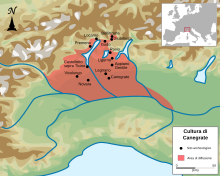Canegrate culture
The Canegrate Culture or Culture of Canegrate originated in the 13th century BC. BC and lasted until the Iron Age . Its center was in western Lombardy , in eastern Piedmont and extended northward into Ticino . The culture was named after the village of Canegrate near Milan , where from 1926, under the direction of Guido Sutermeister, around 50 graves with ceramic and metal additions were found. In total, this and another necropolis in the vicinity has 165 preserved tombs. The Canegrate culture shows similarities in terracotta production with finds from Provence , Savoy , Isère , Valais , the Upper Rhine and the east of France, and it is considered part of the urnfield culture . Her relatives had probably immigrated from the alpine zone.
On the basis of the funeral customs one suspected early on a Protoceltic immigration, but such a cultural assignment is also made for the Scamozzi culture. The origin of the Celtic Insubrians who later lived there is unclear, as is whether there was any relationship to the Canegrate culture. The ceramics indicate a drastic cultural change, because it shows clearly different characteristics than those of the previous culture , the Scamozzina culture .
The first necropolis came to light in Canegrate near the Santa Colomba church in 1926. In 1953 new artefacts were discovered in the course of building a house, in 1956 further finds followed in the primary school "Giuseppe Gajo", which was located about 700 m south of the said church. While Sutermeister was in charge of the excavations in the late 1920s, Ferrante Rittatore Vonwiller took on this task in the second necropolis from 1953 to 1956 . In the urns , almost only personal items such as necklaces or rings were found, and only four swords were found in total. The graves were therefore not an occasion to objectify the social hierarchy. About 30% of the total of 200 graves that the necropolis originally housed, and of which 165 were saved, belonged to children or adolescents. The life expectancy of the residents was low.
Presumably there were several villages near the two necropolises, including Gabinella near Legnano . Further necropolises were found in Appiano Gentile and Ligurno , then in the Swiss canton of Ticino, more precisely in Gudo , Rovio , Locarno , Giubiasco and Bellinzona , then in Novarese in Novara itself and in Vicolungo and in Castelletto sopra Ticino , and finally in Premeno . Settlements, on the other hand, have hardly been known so far, so that knowledge about the culture is derived almost exclusively from funeral customs.
There were hardly any culturally contaminating contacts with the Terramare culture , even if there was, however, a not very intensive trade network, as has recently been shown. Even the bronze works are of completely different chemical composition, so that contacts existed more towards the north, as far as Central Europe, and towards the west. The culture dissolved in the Golasecca culture, mixing with other groups.
literature
- Gisella Maliverni: La cultura di Canegrate. tesi di laurea, Padua 2008.
- Ferrante Rittatore: Sulla cronologia della cultura di Canegrate. In: Rivista di scienze preistoriche 12, 1-2 (1957) 99-103.
Remarks
- ↑ Emma Blake: Social Networks and Regional Identity in Bronze Age Italy , Cambridge University Press, 2014, p. 28.
- ↑ La sezione Preistorica e Protostorica ( Memento of the original from September 15, 2017 in the Internet Archive ) Info: The archive link was inserted automatically and has not yet been checked. Please check the original and archive link according to the instructions and then remove this notice. , Museo Archeologico Paolo Giovio, Como.
- ↑ Emma Blake: Social Networks and Regional Identity in Bronze Age Italy , Cambridge University Press, 2014, p. 128 f.
- ↑ Emma Blake: Social Networks and Regional Identity in Bronze Age Italy , Cambridge University Press, 2014, p. 119.


